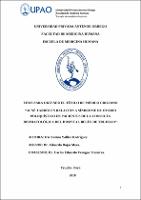Mostrar el registro sencillo del ítem
Acné tardío en relación a síndrome de ovario poliquístico en pacientes de la consulta dermatológica del Hospital Belén de Trujillo
| dc.contributor.advisor | Rojas Meza, Eduardo | |
| dc.contributor.author | Yallico Rodríguez, Iris Yanina | |
| dc.creator | Yallico Rodríguez, Iris Yanina | |
| dc.date.accessioned | 2018-10-02T22:06:41Z | |
| dc.date.available | 2018-10-02T22:06:41Z | |
| dc.date.issued | 2018 | |
| dc.identifier.uri | https://hdl.handle.net/20.500.12759/4360 | |
| dc.description.abstract | Objetivo: Establecer la relación de Acné Tardío y el Síndrome de Ovario Poliquíst ico en pacientes de la consulta Dermatológica del Hospital Belén de Trujillo. Material y Método: Se llevó a cabo un estudio analítico, observacional, transversal en pacientes de la consulta de Dermatología con acné del Hospital Belén de Trujillo atendidas durante 2014 – 2017 en base a la revisión de historias clínicas. La muestra fue de 140 historias, determinada por los criterios de selección. Resultados: La frecuencia de acné tardío en la consulta fue 30.7% (43 pacientes), mientras que el Síndrome de Ovario Poliquístico se identificó en 60.7% de todos los pacientes. La asociación de acné tardío con Síndrome de Ovario Poliquístico solo se encontró en 25.88% de los pacientes con SOP, con valor p=0.123. La edad promedio fue 22.18±3.49 años en los pacientes con SOP y las variables con relación estadísticamente significativa a SOP fueron el IMC normal en 81.17% OR= 0.76 (p=0.035), ocupación con mayor porcentaje fue la de estudiante en 55.29% OR= 6.15 (p=0.029), oligo/amenorrea en 68.24% OR= 11.86 (p=0.000), hiperandrogenismo clinico en 75.29% OR= 4.29 (p=0.000) e imagen ecográfica correspondiente a SOP en 75.29% OR=7.91 (p=0.000). Conclusiones: No existe relación de Acné Tardío y el Síndrome de Ovario Poliquístico. | es_PE |
| dc.description.abstract | Objective: To establish the relation of post adolescent acne and Polycystic Ovarian Syndrome in in patients of the dermatological consultation of the Belén de Trujillo Hospital. Material and Methods: An analytical, observational, cross-sectional study was carried in patients from the dermatology clinic with acne from the Belen de Trujillo Hospital attended during 2014 - 2017 based on the review of clinical records. The sample was 140 stories, determined by the selection criteria. Results: The frequency of post adolescence acne in the consultation was 30.7% (43 patients), while Polycystic Ovarian Syndrome was identified in 60.7% of all patients. The association of post adolescence acne with Polycystic Ovarian Syndrome was only found in 25.88% of patients with PCOS, with p = 0.123. The average age was 22.18 ± 3.49 years in the patients with PCOS and the variables with statistically significant relationship to PCOS were the normal BMI in 81.17% OR = 0.76 (p = 0.035), occupation with the highest percentage was that of the student in 55.29% OR = 6.15 (p = 0.029), oligo / amenorrhea in 68.24% OR = 11.86 (p = 0.000), clinical hyperandrogenism in 75.29% OR = 4.29 (p = 0.000) and ultrasound image corresponding to SOP in 75.29% OR = 7.91 (p = 0.000). Conclusions: There is no relationship between post adolescence Acne and Polycystic Ovarian Syndrome. | en_US |
| dc.description.uri | Tesis | es_PE |
| dc.format | application/pdf | es_PE |
| dc.language.iso | spa | es_PE |
| dc.publisher | Universidad Privada Antenor Orrego - UPAO | es_PE |
| dc.relation.ispartofseries | T_MED.HUMA_2440 | |
| dc.rights | info:eu-repo/semantics/openAccess | es_PE |
| dc.source | Universidad Privada Antenor Orrego | es_PE |
| dc.source | Repositorio Institucional - UPAO | es_PE |
| dc.subject | Síndrome del ovario poliquístico | es_PE |
| dc.subject | Acné vulgar | es_PE |
| dc.title | Acné tardío en relación a síndrome de ovario poliquístico en pacientes de la consulta dermatológica del Hospital Belén de Trujillo | es_PE |
| dc.type | info:eu-repo/semantics/bachelorThesis | es_PE |
| thesis.degree.level | Título Profesional | es_PE |
| thesis.degree.grantor | Universidad Privada Antenor Orrego. Facultad de Medicina Humana | es_PE |
| thesis.degree.name | Médico Cirujano | es_PE |
| thesis.degree.discipline | Medicina Humana | es_PE |
Ficheros en el ítem
Este ítem aparece en la(s) siguiente(s) colección(es)
-
Medicina Humana [2717]

